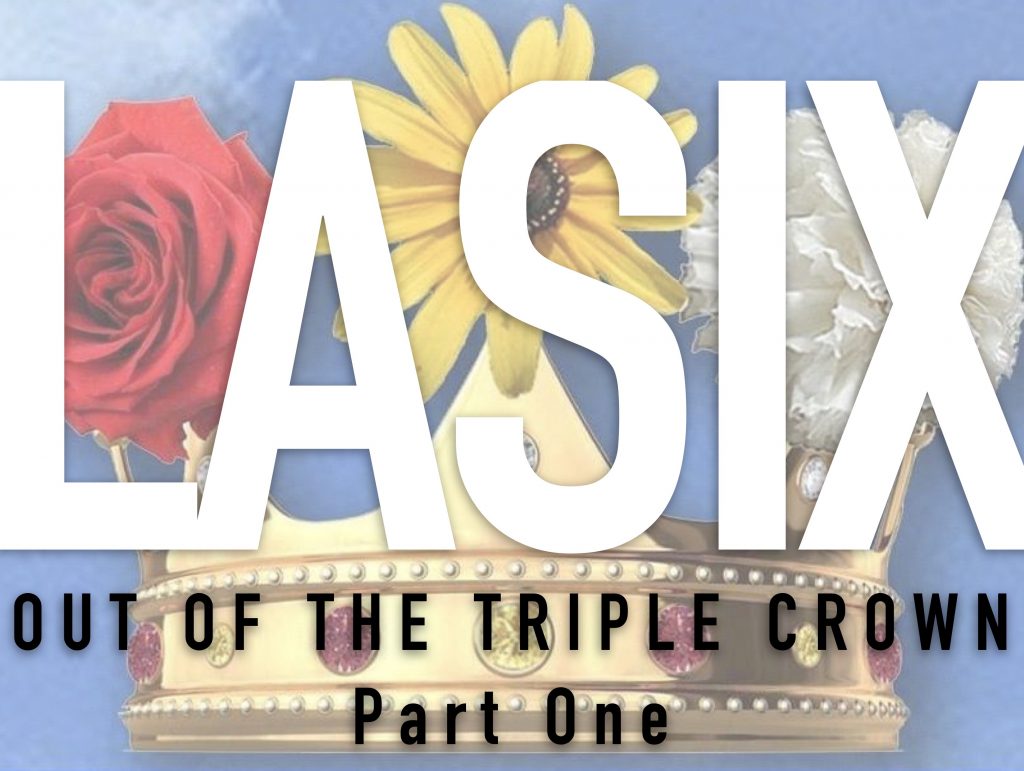
When you look at the Kentucky Derby program this year you won’t see any “L’s” in the column marked M/E for medication and equipment—the medication the “L” represents being Lasix, one of the brand names for Furosemide.
This year will be the first year any Triple Crown race will run Lasix-free on race-day in 26 years. The last was the 1995 Belmont Stakes. Although there were certain exceptions to the Kentucky Derby and the Preakness, Maryland had much more stringent rules to qualify for Lasix than Kentucky did when both states legalized usage at different times.
Furosemide, is a drug used to aid in the prevention of a condition called Exercise-Induced Pulmonary Hemorrhaging (EIPH) or “bleeding”.
It is most evident in racehorses, caused by high cardiac output which creates great pressure on the lungs during strenuous exercise. This pressure causes the capillaries inside a horse’s lungs to burst and as a result, blood can make its way into the trachea and trickle, and in the most severe cases, pour from the nostrils. In mild cases, a horse may get tired and slow down during a race as they feel their oxygen supply being depleted. In extreme cases of a bleeding attack, a horse can literally drop-dead mid race. And a 1000-pound Thoroughbred dropping and hitting the ground at 30-35 mph, poses a deadly risk to other horses and jockeys. So, the use of Lasix on the surface, seems a no-brainer. The debate on whether Lasix is a is a performance enhancer or a performance enabler has been hotly contested for many, many years.
With the passage of the Horseracing Integrity and Safety Act (HISA) and the installation of the HISA Authority, it is likely race-day Lasix may soon be banned across the United States. The sport will move toward a complete elimination of Lasix by July 1, 2022 when the HISA is scheduled to go into effect.
Kentucky’s Thoroughbred racetracks supported sweeping medication reforms, including the Lasix ban, adopted by the Kentucky Horse Racing Commission (KHRC) in late 2019 and was the first to ban the drug for 2-year-olds beginning at the Keeneland Spring 2020 meet and the following Churchill meet. It was logical that Churchill Downs (CD) would follow suit for a ban in the 2021 Kentucky Derby Grade I. In fact, CD had decided that no qualifying points would be awarded in the Road to the Kentucky Derby prep series of 2020-2021 for any horse that competed on race-day Lasix.
Maryland finally addressed the use of Lasix due to The Stronach Group’s push to adopt regulations imposed at Santa Anita. In 2020, Lasix was banned in all races for 2-year-olds after TSG refused to let the Maryland Jockey Club card any 2-year-old races. The 2-year-old restrictions carried over with added restrictions for graded stakes in 2021 which includes the Preakness Stakes.
The next to follow was New York, the state to be the last holdout to allow the drug in racing at all. NYRA announced that it would ban race-day Lasix in all stakes races for 2021. This will be the first Lasix-free Belmont Stakes since 1986.
But that’s where regulations stop being consistent and go to convoluted. As noted, Maryland banned Lasix for 2-year-old races in 2020 and all graded stakes in 2021. But if your horse races on Lasix in Maryland and goes out of state to race the horse must race on Lasix in that jurisdiction. If it does not there is a 60-day penalty if that horse comes back to Maryland to race on Lasix. However, if that jurisdiction has a restriction on a graded stakes race, e.g., the Pegasus World Cup, that is waived.
In New York in 2020, NYRA began a ban on race-day Lasix for all races restricted to 2-year-olds. NYRA banned Lasix in all stakes races for 2021. Current New York State Gaming Commission rules require a waiver to race with Lasix administered within 48 hours of a race, based on documented exercise-induced pulmonary bleeding. No such waivers will be granted for 2-year-olds or horses entered in stakes in 2021.
Kentucky’s reforms also apply to horses stabled at Keeneland’s The Thoroughbred Center in Lexington and the Churchill Downs Training Center in Louisville.
In April 2019 the Thoroughbred Safety Coalition (TSC) was formed with The Stronach Group and Churchill Downs, along with the Breeders’ Cup Limited, Del Mar and Keeneland. TSC announced a gradual phase-out of the only medication allowed to be administered on the day of a race. Beginning in 2020, 2-year-olds were required to run without Lasix at prominent tracks, with the ban extending to stakes races in 2021. This was accomplished.
The Breeder’s Cup World Championships announced in 2020 that the “Win and You’re In” Challenge Series races would be run without Lasix. Additionally, Graded Stakes points for the purpose of selection into a Breeders’ Cup races would only be awarded in Lasix-free graded stakes races.
There are still many questions swirling around about the Lasix ban and the effects on the horses. First and foremost, do all horses bleed? Why is every horse run on Lasix (well, except Runhappy)? Is Lasix a performance enhancing drug (PED)? How did we get here?
Impact on the Triple Crown races
Obviously, the lack of Lasix may impact many of the horses who run in the Kentucky Derby. A full field including top-notch horses will take its toll on any athlete. It’s likely many of these four-legged athletes will come out of the race needing a month’s rest.
With horses resting after the Derby, the entries for the Preakness Stakes may be sketchy. On the other hand, there may be quite a few fresh entries for the 146th edition making it a good race for punters.
The Belmont was always a grueling race for any champion or challenger. This year could be even more so. We could expect horses who did not qualify for the Derby and are rested, to start in the Belmont. And again, there may be a few fresh entries.
Of course, armchair trainers will be second-guessing the lack of Lasix on and the impact on the race and the athletes on social media. Who bled, who didn’t. Who is anti-Lasix and who is pro.
Past The Wire asked Kentucky Derby-winning trainer of 2011 champ Animal Kingdom, Graham Motion for his take on how Lasix will impact the Derby and starters.
Editor: How would/will your approach to the Derby and Triple Crown or any big, graded stakes races differ now that race-day Lasix is no longer allowed?
Motion: Very little, although obviously if you have a horse who you consider to be a bad bleeder you might reconsider your plans. If you have a bleeding episode running in the Derby, coming back in two weeks in the Preakness might be asking too much.
Editor: In training?
Motion: We will continue to use Lasix in the morning as a preventative in some cases, as is done in other parts of the world.
Editor: Have you noticed bleeding in any your runners?
Motion: We often see traces of bleeding when our horses are scoped post race and in morning workouts. Lasix does not eliminate all bleeding, it does however help in many cases. We particularly notice horses tend to bleed more in Florida in the winter.
Editor: What is the impact of bleeding? More rest? Different recovery methods?
Motion: Bleeding can cause respiratory infections if not treated. Antibiotics, nebulizers or inhalers, hyperbaric chamber treatments and salt inhalers all can help with diminishing infection and healing the lungs. Some of this is not helped by the environment that we keep the horses in. Certainly, rest between episodes will help but you still must keep them fit so slower workouts and more time outside may help.
Editor: Question of all questions… Do all horses bleed?
Motion: There is a good chance that most horses bleed at some point with or without Lasix but when we refer to horses bleeding this is often referring to small signs of blood far down the trachea and is not necessarily detrimental every time. I have been surprised that some of my horses that were forced to run without Lasix have not bled or minimally. I realize this will not be the case overtime but perhaps the reality is that we depend on Lasix more than necessary.
Editor: Do you have an opinion on the Lasix in general and the ban?
Motion: I believe that we shouldn’t be medicating horses on race day, it’s an integrity issue. If we continue to breed bleeders to bleeders I would imagine we are not helping the breed in the long run.
Editor: Will the ban weed out cheaters?
Motion: It will only weed out cheaters if we have sufficient supervision. Without more supervision it could enable cheaters who may find something else to use to replace Lasix.
Editor: Opinion on the HBPA lawsuit regarding HISA?
Motion: Disappointing, the status quo is not working.
Read Part Two tomorrow in Past The Wire
For info on our Kentucky Oaks and Kentucky Derby webinar / seminar, click HERE, you won’t want to miss this. Be prepared, be with us!
By Maribeth Kalinich, Editor
EDITED 4/28/2021




